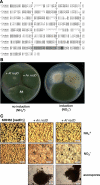The asexual pathogen aspergillus fumigatus expresses functional determinants of Aspergillus nidulans sexual development
- PMID: 18757566
- PMCID: PMC2568067
- DOI: 10.1128/EC.00157-08
The asexual pathogen aspergillus fumigatus expresses functional determinants of Aspergillus nidulans sexual development
Abstract
The major fungal pathogen of humans, Aspergillus fumigatus, lacks a defined sexual cycle, although the presence of genes encoding putative mating type idiomorphs and regulators of Aspergillus sexual development heightens the potential for cryptic sexuality in this deuteromycete. To test the functionality of these genetic determinants, we transferred the alpha box-encoding mat1-1 idiomorph from an A. fumigatus isolate to the homothallic fertile species Aspergillus nidulans. Abundant formation of fruiting bodies (cleistothecia) containing viable ascospores establishes functionality of this mating type gene product in the transgenic strain. Using a similar approach, we also established that the conserved transcriptional regulator from A. fumigatus, the nsdD gene product, can act as a functional, positively acting factor for A. nidulans cleistothecium development; moreover, high-level expression of NsdD in the endogenous host A. fumigatus profoundly alters hyphal development by triggering the formation of coiled hyphae. Our findings demonstrate that the presumably asexual pathogen A. fumigatus encodes functional regulators of mating and sexual development, thereby potentiating the case for cryptic sexuality in this fungal pathogen.
Figures




References
-
- Benjamin, C. R. 1955. Ascocarps of Aspergillus and Penicillium. Mycologia 47669-687.
-
- Braus, G. H., S. Krappmann, and S. E. Eckert. 2002. Sexual development in ascomycetes—fruit body formation of Aspergillus nidulans, p. 215-244. In H. D. Osiewacz (ed.), Molecular biology of fungal development. Marcel Dekker, Inc., New York, NY.
-
- Brown, T., and K. Mackey. 1997. Analysis of RNA by Northern and slot blot hybridization, p. 4.9.1-4.9.16. In F. M. Ausubel, R. Brendt, R. E. Kingston, et al. (ed.), Current protocols in molecular biology. John Wiley & Sons Inc., Hoboken, NJ. - PubMed
-
- Bruggeman, J. 2003. Thesis. Wageningen University, Wageningen, The Netherlands.
-
- Casselton, L. A. 2002. Mate recognition in fungi. Heredity 88142-147. - PubMed
Publication types
MeSH terms
Substances
LinkOut - more resources
Full Text Sources
Other Literature Sources
Molecular Biology Databases

